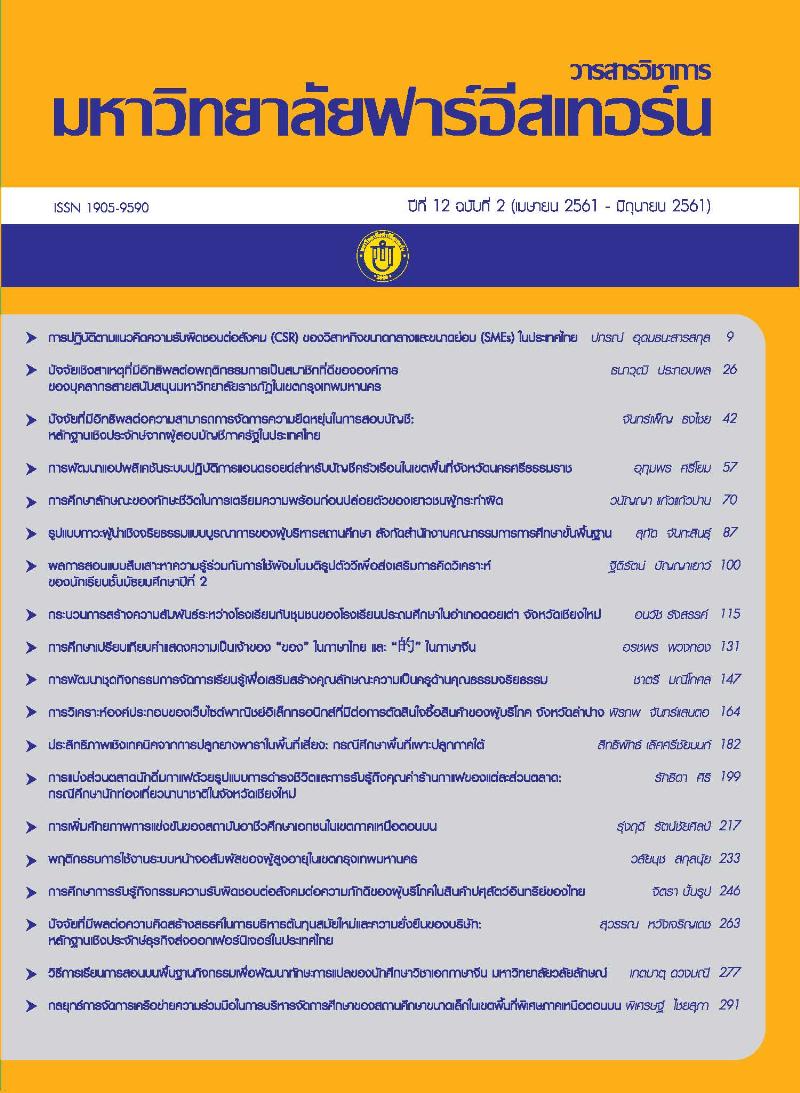A Study on the Characteristics of Life Skills in Preparation for the Release of Juvenile Delinquents
Main Article Content
Abstract
This research is aimed to study on the characteristics of life skills in preparation for release of juvenile delinquents.It was a qualitative research. The informants were 5 people, Those who have committed an offense and have been released. He has also trained at the juvenile vocational training centers in the Bangkok metropolitan region. By Purposive Sampling. The instrument for data collection was the Interview form and semi-structured interviews. Which yielded the reliabilities of 0.60-1.00. Data collection Based on personal history. History of acquittal History of post-censorship behavior And history of punishment by In-Depth Interview, which defines in-depth interviews with document analysis and related research. To determine the basics of appropriate life skills in preparation release. It reflects the characteristics of people with life skills, from the perspective of the informants. Research data were analyzed with content analysis. It was found that the characteristics of life skills in preparation for release include 5 aspects of self-esteem, Social Responsibility, Negotiation, Coping with Emotions And Decision Making. Strong body and mind are important to be trained for self-prepared of juvenile offenders which are to keep away from mistake in the past and to ready to back to community and without to the offense.
Article Details
1. Any views and comments in the Journal of Social Innovation and Lifelong Learning are the authors’ views. The editorial staff have not to agree with those views and it is not considered as the editorial’s responsibility.
2. The responsibility of content and draft check of each article belongs to each author. In case, there is any lawsuit about copyright infringement. It is considered as the authors’ sole responsibility.
3. The article copyright belonging to the authors and The Far Eastern University are copyrighted legally. Republication must be received direct permission from the authors and The Far Eastern University in written form.
References
กรมสุขภาพจิต กระทรวงสาธารณสุข. (2541). คู่มือส่งเสริมสุขภาพจิตนักเรียนระดับมัธยมศึกษาสำหรับครู. กรุงเทพ: สำนักพัฒนาสุขภาพจิต กรมสุขภาพจิต กระทรวงสาธารณสุข. หน้า 2, 12, 45.
กรมสุขภาพจิต กระทรวงสาธารณสุข. (2543). คู่มือการจัดกิจกรรมเพื่อเสริมสร้างทักษะชีวิตสำหรับเด็ก. (พิมพ์ครั้งที่ 4). กรุงเทพฯ: โรงพิมพ์ ร.ส.พ. หน้า 65.
กรมสุขภาพจิต กระทรวงสาธารณสุข. (2545). คู่มือการจัดกิจกรรมเพื่อเสริมสร้างทักษะชีวิตสำหรับเด็ก. (พิมพ์ครั้งที่ 5). กรุงเทพฯ: โรงพิมพ์ ร.ส.พ. หน้า 70.
ชาย โพธิสิตา. (2550). ศาสตร์และศิลป์แห่งการวิจัยเชิงคุณภาพ. (พิมพ์ครั้งที่ 3). กรุงเทพมหานคร: อมรินทร์ พริ้นติ้งแอนพับลิชชิ่ง. หน้า 41.
นงลักษณ์ วิรัชชัย. (2537). สถิติวิเคราะห์สำหรับการวิจัย. พิมพ์ครั้งที่3. กรุงเทพฯ: จุฬาลงกรณ์มหาวิทยาลัย. หน้า 63.
บุษกร อรรถโกมล. (2549). ผลของโปรแกรมฝึกทักษะชีวิตเพื่อเตรียมความพร้อมก่อนปล่อยของเยาวชน ในสถานพินิจและคุ้มครองเด็กและเยาวชนจังหวัดเชียงใหม่. เชียงใหม่: วิทยานิพนธ์ปริญญามหาบัณฑิต. มหาวิทยาลัยราชภัฏเชียงใหม่. หน้า 12.
ภูมิภัทร ปาลกะวงศ์ ณ อยุธยา. (2547). ผลของโปรแกรมแนะแนวกลุ่มต่อการพัฒนาทักษะชีวิตและเปลี่ยนเจตคติต่อพฤติกรรมการทะเลาะวิวาทของเด็กและเยาวชนชายในสถานพินิจและคุ้มครองเด็กและเยาวชนบ้านมุทิตา. ปริญญาศิลปศาสตรมหาบัณฑิต, สาชาจิตวิทยาการศึกษาและแนะแนว บัณฑิตวิทยาลัย, มหาวิทยาลัยเกษตรศาสตร์. หน้า 4, 27, 31, 75.
วิพาพร บุญวงค์. (2551). การเปรียบเทียบพฤติกรรมการเห็นคุณค่าในตนเองและความคิดสร้างสรรค์ของเด็ก ปฐมวัยที่ได้รับการจัดประสบการณ์แบบไฮสโคปกับการจัดประสบการณ์แบบไฮสโคปกับการจัด ประสบการณ์แบบปกติ. วิทยานิพนธ์ครุศาสตรมหา บัณฑิตสาขาวิชาการจัดการการเรียนรู้ มหาวิทยาลัยราชภัฎพระนครศรีอยุธยา. หน้า 14.
สธญ ภู่คง และอ้อมเดือน สดมณี. (2549). การวิเคราะห์ข้อมูลคุณภาพ การวิจัยเชิงคุณภาพเบื้องต้น. กรุงเทพมหานคร: สถาบันวิจัยพฤติกรรมศาสตร์ มหาวิทยาลัยศรีนครินทรวิโรฒ. หน้า 60-88.
สิทธิ์ ธีรสรณ์. (2550). เทคนิคการเขียนรายงานวิจัย. พิมพ์ครั้งที่ 1, กรงเทพมหานคร: โรงพิมพ์จุฬาลงกรณ์ มหาวิทยาลัย. หน้า 65
โสภิตา เหมาะหมาย (2557). ผลของโปรแกรมเสริมสร้างทักษะชีวิตในการป้องกันการดื่มเครื่องดื่ม แอลกอฮอล์ของนักเรียนมัธยมศึกษาตอนต้น โรงเรียนวีรวัฒน์โยธิน ตำบลนอกเมือง อำเภอเมืองจังหวัดสุรินทร์. วารสารวิจัยและพัฒนาระบบสุขภาพ. ปีที่ 7 ฉบับที่ 2 กรกฎาคม-ตุลาคม 2557 หน้า 273-283.
สำนักงานพัฒนาระบบงานยุติธรรมเด็กและเยาวชน. (2551). รายงานสถิติคดีประจำปี. กลุ่มงานข้อมูลและสารสนเทศ. หน้า 22, 65.
อุษณี ลลิตผสาน. (2551). การวิจัยและพัฒนาแบบฝึกทักษะการตัดสินใจที่มีผลต่อประสิทธิภาพการบริหารเวลาและผลสัมฤทธิ์ทางการเรียนของนักเรียนชั้นมัธยมศึกษาตอนปลาย: การประยุกต์ใช้ทฤษฎีเกม. วิทยานิพนธ์ กศ.ม. สาขาวิชาวิจัยการศึกษา. บัณฑิตวิทยาลัย จุฬาลงกรณ์มหาวิทยาลัย. หน้า 23
Atena Naseria; & Narges Babakhani. (2014). The effect of life skills training on physical and verbalaggression male delinquent adolescents Marginalized in Karaj. Procedia Social and Behavioral Sciences 116. pp. 4875-4879.
De Jong, T. (1995). Proposed General Guidelines for a Life skills Curriculum Framework. Johannesburg: Centre for Education Policy Development. p. 93.
Mangulkar, Whitman; & Posner. (2001). Approach to Child and Adolescent Health Human Development. Washington, DC: Education Development Center. p. 22, 55.
Marie, Ann Conerly. (1997). The Effect of Life Skills Instruction on Locus of Control in Adult Male Inmates. The University of Southern Mississippi. From http://www.umi.com/dissertations/fullcit/9806474. online.
Maslow, A. H. (2000). The Maslow Nusiness Rreader. New York: John Wiley & Sons.
Minichiello, V; Aroni , R; Timewell, E; & Alexander,L. (1990). In-Depth Interviewing: Researching people. Melbourne: Longman Cheshire. p. 43.
Nelson Jones, (1997). Practical Counselling and Helping Skills: How to Use the Life Skills Counselling Model. 4th ed. London: Cassell. pp. 7-8.
Patton, M.Q. (2002). Qualitative Research and evaluation methods.3rded. California: SAGE Publications. p.143.
Shahram Vaziri; et al. (2014). Group counseling efficiency based on choice theory on prisoners’ responsibility increase. Procedia-Social and Behavioral Sciences 128 (2014) pp. 311-315.
Spiegler, Michael D., & Guevremont, David C. (1998). Contemporary Behavior Therapy. 3rded. New York: Brooks/Cole.
Thompson, C.L; Rudolph, L.B; & Henderson, D. (2004). Counseling children. 7thed Belmont, CA: Brooks/Cole. p. 4.
World Health Organization. (1994). Life skills education for children and adolescents in schools. Geneva: Switzerland. Online. p. 1, 5.

